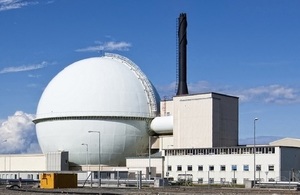Free at last as jammed fuel is lifted out
Work is now under way to overcome a 20-year conundrum that has hampered decommissioning of the Dounreay Fast Reactor in Scotland.

The iconic Dounreay Fast Reactor
When the dome-shaped experimental reactor closed in 1977, most of the core fuel was removed.
But follow-up work came to a halt when some of the metallic casings in the zone surrounding the core were found to be swollen and jammed. Almost 1,000 – around two-thirds of the total - were left in place.
Made of stainless steel, the casings, known as breeder elements, contained natural uranium and were designed to produce more fuel for use in other reactors.
Now, after many years of work to design and test remotely operated equipment, a decommissioning team has started to recover the elements.
Decommissioning the 50-year-old reactor is one of the most technically challenging projects in the NDA estate and removing the breeder elements has been a top priority.
The removal work is expected to take less than 3 years, after which dismantling of the landmark reactor can begin.
David Peattie, NDA Chief Executive, said:
Dealing with this material is one of the highest priorities anywhere for the NDA, not just at Dounreay but across our UK sites. The safe and timely retrieval of the breeder material is crucial to both the site’s closure programme and the national defueling programme.
I am very pleased with this achievement which is a great example of how the Dounreay team and the NDA can work together to deliver results of national importance.

MP Jamie Stone looks on as team members monitor removal of the breeder material
During a visit to the reactor, Jamie Stone, MP for Caithness, Sutherland and Easter Ross, said:
Actually watching on screen the removal of an element from the reactor core was fascinating. Seeing the intricate techniques and skills, and the special locally designed equipment being used was absolutely inspirational.
In an age when sometimes you begin to wonder where British technology is going, it is hugely encouraging to see what is being done at Dounreay. I take my hat off to the workforce.
When the damaged elements were discovered, decommissioning effectively stopped for 20 years, until the decision was taken in 2000 to close down Dounreay and the creation of the NDA a few years later gave fresh momentum to the task.
The elements were immersed in some 57 tonnes of highly reactive liquid metal which had to be removed and destroyed before remotely operated cameras could inspect the condition of the material. This difficult, hazardous programme took more than 10 years.
Now, following extensive research and development trials inside the plant and at a test rig on the outskirts of Thurso, work has started to remove the remaining breeder material.
Watch the DFR breeder material removal process
Dounreay Fast Reactor
After removal, the elements are being transferred to a purpose-built facility, where they are being cut open to remove the uranium fuel, cleansed of any traces of liquid metal and packaged in containers for dispatch to Sellafield. About 40 tonnes of breeder recovered previously has already been sent there.
When all the breeder material has been removed, work can begin on taking the reactor apart.
Main support contractor: JGC Engineering & Technical Services Ltd
About the Dounreay Fast Reactor (DFR)
-
the DFR was built during the 1950s at a time when there was a world-wide shortage of uranium for electricity generation
-
It became the world’s first fast reactor to provide electricity to a national grid, providing enough power for a small town like Thurso (population approx 9,000)
-
DFR’s reactor core was surrounded by a blanket of natural uranium elements that, when exposed to the effects of the radiation, would ‘breed’ to create a new fuel, plutonium
-
UK experimentation with fast breeders came to an end in the 1980s
-
decommissioning DFR is one of the most significant challenges in the UK today. It was one of only two fast reactors ever built in the UK, both at Dounreay.
-
when the breeder material is all removed, the reactor and its circuits will be dismantled, followed by final decontamination of the structures
-
the dome and associated structures will be demolished
Dounreay Site Restoration Ltd (DSRL)
DSRL, a company owned by Cavendish Dounreay Partnership, is responsible for decommissioning the UK’s former centre of fast reactor research on behalf of the NDA.
Updates to this page
-
Updated the link to the longer version of the video
-
Updated information
-
First published.